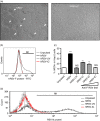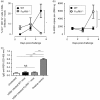Contribution of Fcγ receptors to human respiratory syncytial virus pathogenesis and the impairment of T-cell activation by dendritic cells
- PMID: 26451966
- PMCID: PMC4693880
- DOI: 10.1111/imm.12541
Contribution of Fcγ receptors to human respiratory syncytial virus pathogenesis and the impairment of T-cell activation by dendritic cells
Abstract
Human respiratory syncytial virus (hRSV) is the leading cause of infant hospitalization related to respiratory disease. Infection with hRSV produces abundant infiltration of immune cells into the airways, which combined with an exacerbated pro-inflammatory immune response can lead to significant damage to the lungs. Human RSV re-infection is extremely frequent, suggesting that this virus may have evolved molecular mechanisms that interfere with host adaptive immunity. Infection with hRSV can be reduced by administering a humanized neutralizing antibody against the virus fusion protein in high-risk infants. Although neutralizing antibodies against hRSV effectively block the infection of airway epithelial cells, here we show that both, bone marrow-derived dendritic cells (DCs) and lung DCs undergo infection with IgG-coated virus (hRSV-IC), albeit abortive. Yet, this is enough to negatively modulate DC function. We observed that such a process is mediated by Fcγ receptors (FcγRs) expressed on the surface of DCs. Remarkably, we also observed that in the absence of hRSV-specific antibodies FcγRIII knockout mice displayed significantly less cellular infiltration in the lungs after hRSV infection, compared with wild-type mice, suggesting a potentially harmful, IgG-independent role for this receptor in hRSV disease. Our findings support the notion that FcγRs can contribute significantly to the modulation of DC function by hRSV and hRSV-IC. Further, we provide evidence for an involvement of FcγRIII in the development of hRSV pathogenesis.
Keywords: Fcγ receptors; dendritic cells; human respiratory syncytial virus; immune complexes; neutralizing antibodies; palivizumab.
© 2015 John Wiley & Sons Ltd.
Figures







Similar articles
-
Immune-Modulation by the Human Respiratory Syncytial Virus: Focus on Dendritic Cells.Front Immunol. 2019 Apr 15;10:810. doi: 10.3389/fimmu.2019.00810. eCollection 2019. Front Immunol. 2019. PMID: 31057543 Free PMC article. Review.
-
Contribution of Fcγ Receptor-Mediated Immunity to the Pathogenesis Caused by the Human Respiratory Syncytial Virus.Front Cell Infect Microbiol. 2019 Mar 29;9:75. doi: 10.3389/fcimb.2019.00075. eCollection 2019. Front Cell Infect Microbiol. 2019. PMID: 30984626 Free PMC article. Review.
-
Bovine IgG Prevents Experimental Infection With RSV and Facilitates Human T Cell Responses to RSV.Front Immunol. 2020 Aug 6;11:1701. doi: 10.3389/fimmu.2020.01701. eCollection 2020. Front Immunol. 2020. PMID: 32849597 Free PMC article.
-
A single, low dose of a cGMP recombinant BCG vaccine elicits protective T cell immunity against the human respiratory syncytial virus infection and prevents lung pathology in mice.Vaccine. 2017 Feb 1;35(5):757-766. doi: 10.1016/j.vaccine.2016.12.048. Epub 2017 Jan 5. Vaccine. 2017. PMID: 28065474
-
Modulation of Host Immunity by Human Respiratory Syncytial Virus Virulence Factors: A Synergic Inhibition of Both Innate and Adaptive Immunity.Front Cell Infect Microbiol. 2017 Aug 16;7:367. doi: 10.3389/fcimb.2017.00367. eCollection 2017. Front Cell Infect Microbiol. 2017. PMID: 28861397 Free PMC article. Review.
Cited by
-
Immune-Modulation by the Human Respiratory Syncytial Virus: Focus on Dendritic Cells.Front Immunol. 2019 Apr 15;10:810. doi: 10.3389/fimmu.2019.00810. eCollection 2019. Front Immunol. 2019. PMID: 31057543 Free PMC article. Review.
-
Contribution of Fcγ Receptor-Mediated Immunity to the Pathogenesis Caused by the Human Respiratory Syncytial Virus.Front Cell Infect Microbiol. 2019 Mar 29;9:75. doi: 10.3389/fcimb.2019.00075. eCollection 2019. Front Cell Infect Microbiol. 2019. PMID: 30984626 Free PMC article. Review.
-
Cell surface detection of vimentin, ACE2 and SARS-CoV-2 Spike proteins reveals selective colocalization at primary cilia.Sci Rep. 2022 Apr 29;12(1):7063. doi: 10.1038/s41598-022-11248-y. Sci Rep. 2022. PMID: 35487944 Free PMC article.
-
Respiratory Syncytial Virus Infects Primary Neonatal and Adult Natural Killer Cells and Affects Their Antiviral Effector Function.J Infect Dis. 2019 Feb 15;219(5):723-733. doi: 10.1093/infdis/jiy566. J Infect Dis. 2019. PMID: 30252097 Free PMC article.
-
In Vitro Enhancement of Respiratory Syncytial Virus Infection by Maternal Antibodies Does Not Explain Disease Severity in Infants.J Virol. 2017 Oct 13;91(21):e00851-17. doi: 10.1128/JVI.00851-17. Print 2017 Nov 1. J Virol. 2017. PMID: 28794038 Free PMC article.
References
-
- Hacking D, Hull J. Respiratory syncytial virus – viral biology and the host response. J Infect 2002; 45:18–24. - PubMed
-
- Mejias A, Chavez‐Bueno S, Jafri HS, Ramilo O. Respiratory syncytial virus infections: old challenges and new opportunities. Pediatr Infect Dis J 2005; 24(11 Suppl):S189–96, discussion S96‐7. - PubMed
-
- Chang J, Braciale TJ. Respiratory syncytial virus infection suppresses lung CD8+ T‐cell effector activity and peripheral CD8+ T‐cell memory in the respiratory tract. Nat Med 2002; 8:54–60. - PubMed
MeSH terms
Substances
LinkOut - more resources
Full Text Sources
Other Literature Sources
Medical
Molecular Biology Databases

